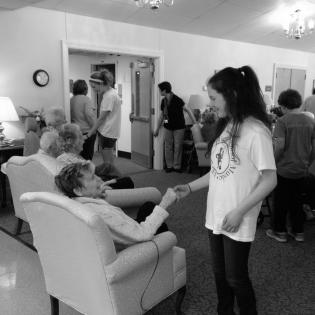Exploring Our Legacy of Giving
In this lesson, learners explore their personal responsibility to the community. They recognize that everyone has something to give, and that includes them. The learners brainstorm local philanthropists and positive traits of their own communities. They assess local needs and make a plan to address one need through volunteering or advocacy at a later date.
The learner will:
- generate a list of positive traits of the local community.
- discuss possible projects for addressing a community need.
- identify local philanthropists.
- Completed handout from the previous lesson: Our Community Homework
The Gift of All: a Community of Givers, produced by The S.O.U.L. of Philanthropy along with The Grand Rapids Community Foundation and Calvin College. Copyright © Grand Rapids Public Library, City of Grand Rapids, Michigan, 2008, 2009. Streaming video available at https://www.youtube.com/watch?v=dmaJoQicCEE
Learning to Give. "SOUL of Philanthropy" project. Includes links to video, related quotations, and briefing papers (biographies)
Instructions
Anticipatory Set
Reflect on these words from the documentary The Gift of All: A Community of Givers: "In a healthy community, everyone is important. Everyone has something to give." Discuss what that statement means. What does a "healthy community" mean, and who is "everybody"? Ask the learners whether they are important to the community.
The handout from the previous lesson asked them to name two positive attributes of the community and two issues that need improvement. Have them share their homework with one other person. After a few minutes of sharing, ask for volunteers to share some positive traits of the community. List these traits on chart paper with a heading such as "What Makes Our Community Great."
Lay out all of the drawings of the community in ten years. Invite everyone to stand around the drawings. Have each person in turn explain what issues they addressed and how they envision the future of the community. This will be a thoughtful time to build empowerment, trust, and respect. After the discussion, they may choose a project based on one or more of the issues raised here.
This discussion may lead to a service project. Lead them to recognize that the issues they identified in their community can be addressed by this group because they are important members of this community, and they have "something to give." The people in the documentary said repeatedly that they have great respect for the people who give time and talent and touch the lives of the people in the community to a greater degree than those who give money.
Discuss the philanthropists in your community. This includes people who give in many ways. Encourage them to think of people they know and encounter that they might not have recognized as philanthropists before: People who volunteer in their faith-based organization or school, the crossing guard, family members who help others.
Brainstorm a list of people in your community who volunteer and share time, talent, and treasure for the common good. Include the names from the community whose names are on buildings and in the names of parks. In the next lesson, they will each be doing research, conducting interviews, and writing a story about one person. The story will be shared with others outside this class.
Handouts
Philanthropy Framework
-
Strand PHIL.I Definitions of Philanthropy
-
Standard DP 01. Define Philanthropy
-
Benchmark MS.1 Define philanthropy as individuals and organizations providing their time, talent, and/or treasures intended for the common good throughout history and around the world. Give examples.
-
Benchmark MS.4 Give examples of how individuals have helped others.
-
-
-
Strand PHIL.II Philanthropy and Civil Society
-
Standard PCS 01. Self, citizenship, and society
-
Benchmark MS.4 Describe the characteristics of someone who helps others.
-
-
Standard PCS 03. Philanthropy and Economics
-
Benchmark MS.7 Give examples of common resources in the community.
-
-
Standard PCS 05. Philanthropy and Government
-
Benchmark MS.2 Define civic virtue.
-
Benchmark MS.3 Identify the relationship between individual rights and community responsibilities.
-
Benchmark MS.8 Define civil society.
-
-
-
Strand PHIL.III Philanthropy and the Individual
-
Standard PI 01. Reasons for Individual Philanthropy
-
Benchmark MS.1 Define and give examples of the motivations for giving and serving.
-
Benchmark MS.2 Explain and give examples of enlightened self-interest, egoism, and altruism as they relate to philanthropy.
-
Benchmark MS.5 Describe the responsibility students have to act in the civil society sector to improve the common good.
-
-
-
Strand PHIL.IV Volunteering and Service
-
Standard VS 01. Needs Assessment
-
Benchmark MS.1 Identify a need in the school, local community, state, nation, or world.
-
-
Standard VS 02. Service and Learning
-
Benchmark MS.1 Select a service project based on interests, abilities and research.
-
-
